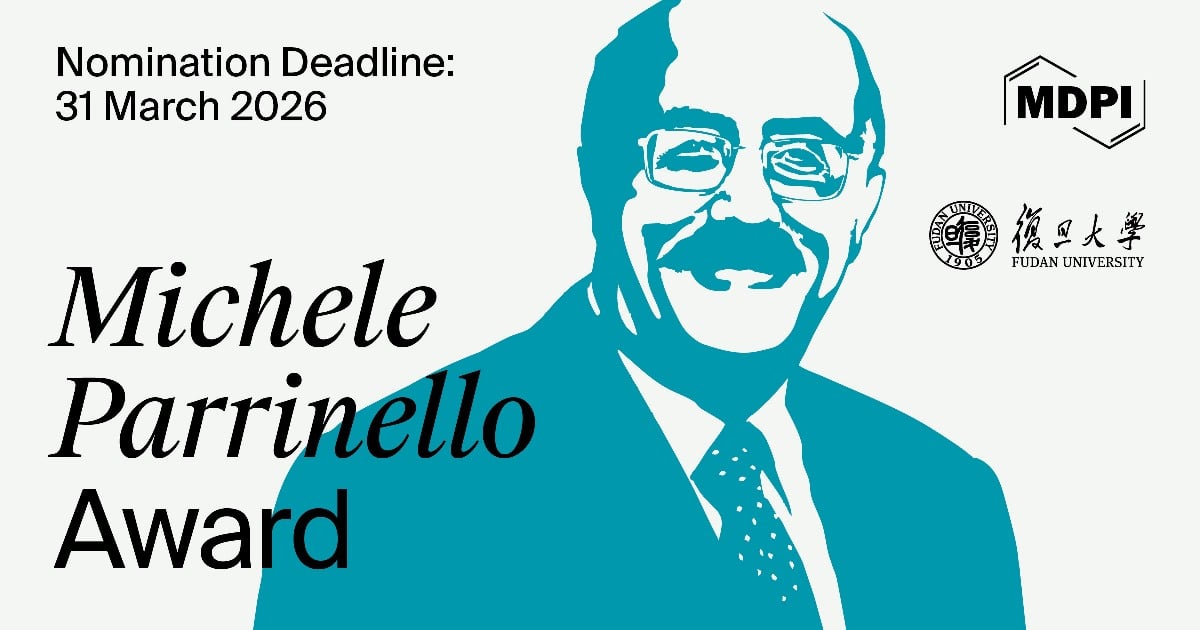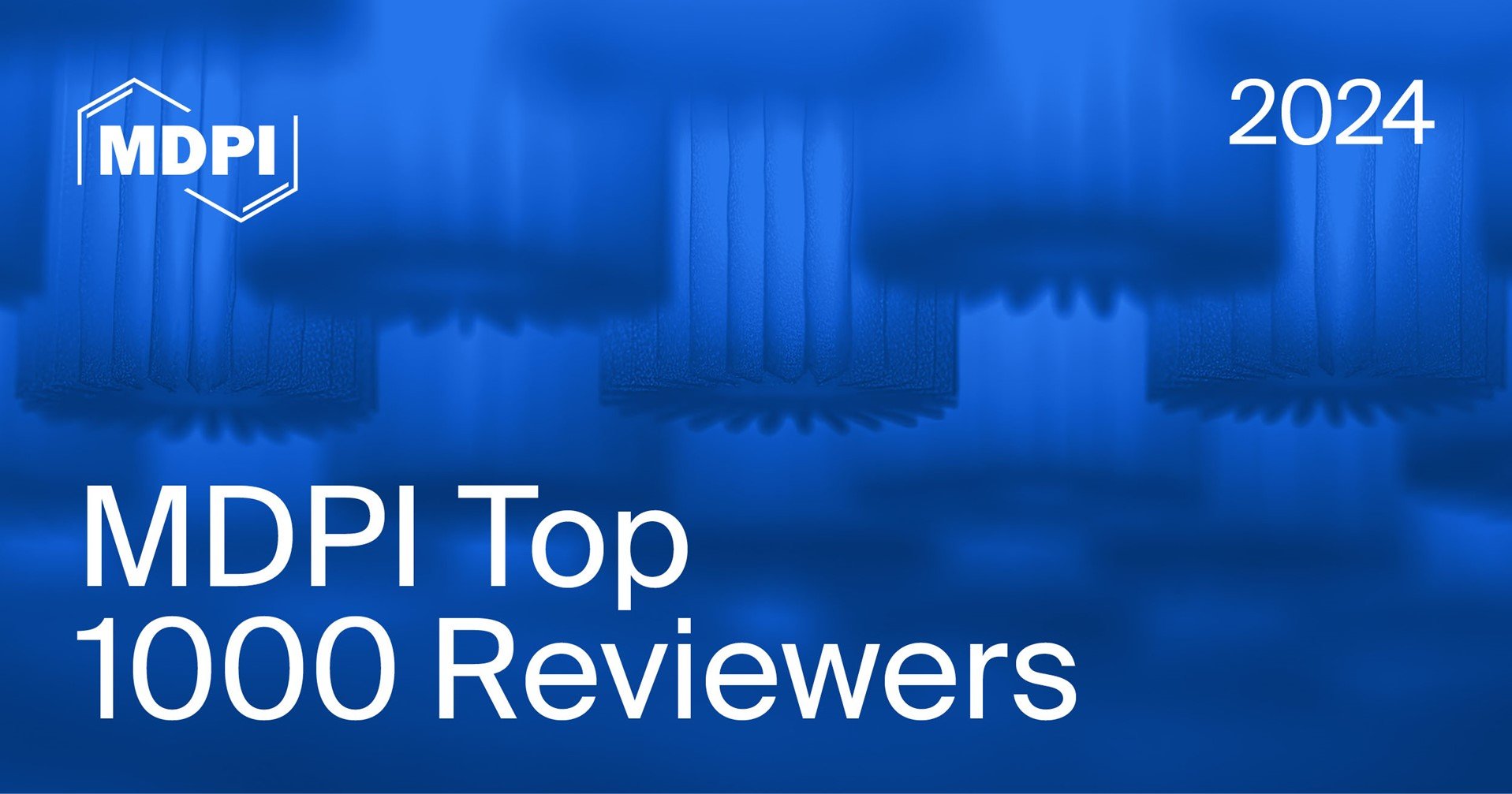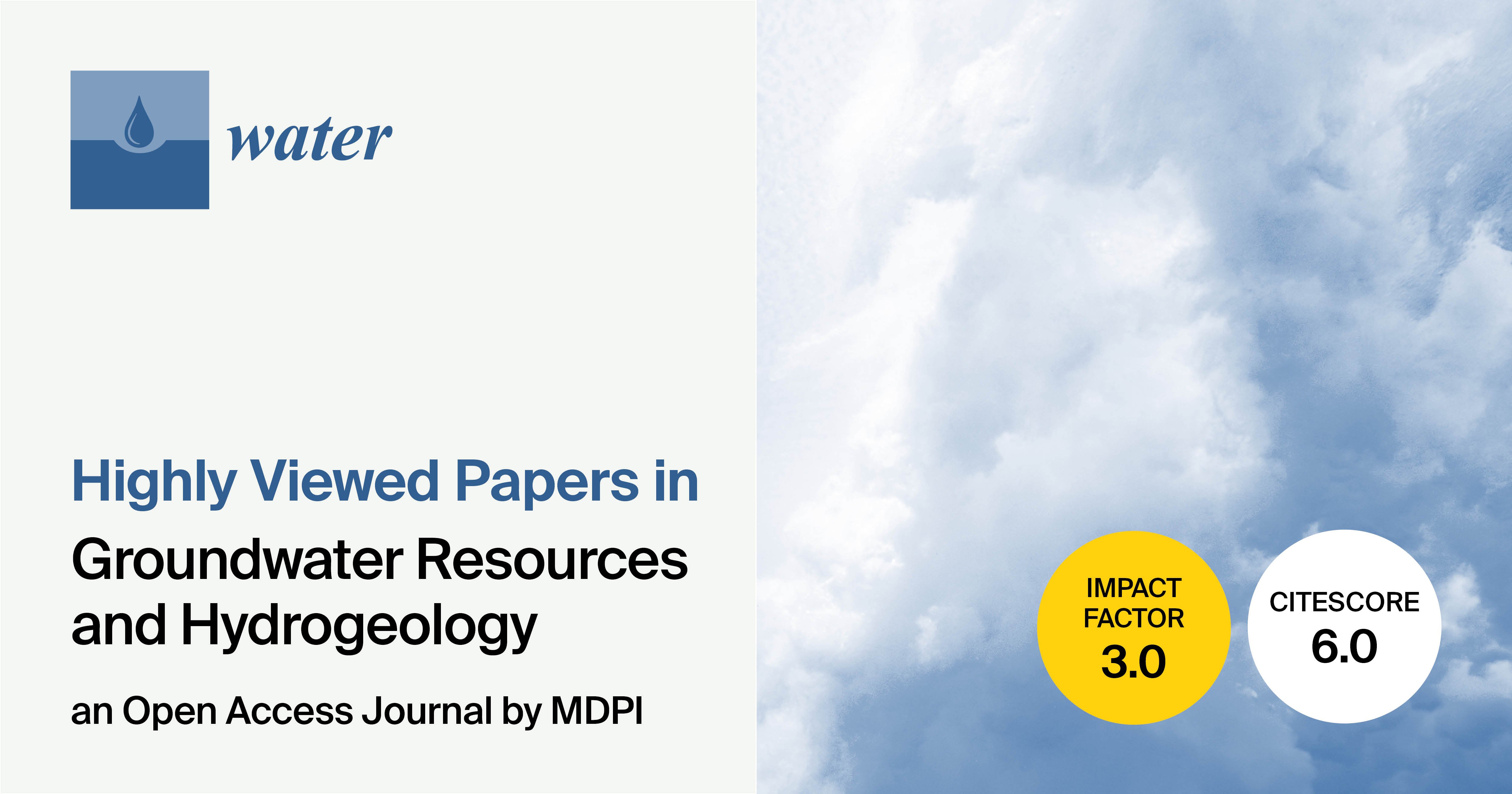Journal Description
Water
Water
is a peer-reviewed, open access journal on water science and technology, including the ecology and management of water resources, and is published semimonthly online by MDPI. Water collaborates with the Stockholm International Water Institute (SIWI). In addition, the American Institute of Hydrology (AIH), Polish Limnological Society (PLS) and Japanese Society of Physical Hydrology (JSPH) are affiliated with Water and their members receive a discount on the article processing charges.
- Open Access— free for readers, with article processing charges (APC) paid by authors or their institutions.
- High Visibility: indexed within Scopus, SCIE (Web of Science), Ei Compendex, GEOBASE, GeoRef, PubAg, AGRIS, CAPlus / SciFinder, Inspec, and other databases.
- Journal Rank: JCR - Q2 (Water Resources) / CiteScore - Q1 (Aquatic Science)
- Rapid Publication: manuscripts are peer-reviewed and a first decision is provided to authors approximately 19.1 days after submission; acceptance to publication is undertaken in 2.6 days (median values for papers published in this journal in the first half of 2025).
- Recognition of Reviewers: reviewers who provide timely, thorough peer-review reports receive vouchers entitling them to a discount on the APC of their next publication in any MDPI journal, in appreciation of the work done.
- Companion journals for Water include: GeoHazards.
- Journal Clusters of Water Resources: Water, Journal of Marine Science and Engineering, Hydrology, Resources, Oceans, Limnological Review, Coasts.
Impact Factor:
3.0 (2024);
5-Year Impact Factor:
3.3 (2024)
Latest Articles
Performance Evaluation of the SRM and GRxJ—CemaNeige Models for Daily Streamflow Simulation in Two Catchments with Snow and Rain Dominated Hydrological Regimes
Water 2025, 17(23), 3413; https://doi.org/10.3390/w17233413 (registering DOI) - 30 Nov 2025
Abstract
This study evaluated the Snowmelt-Runoff Model (SRM) and the Génie Rural à X Paramètres Journalier (GRxJ) model family, analyzing the latter both independently and in combination with the CemaNeige snow module. SRM and GRxJ represent snowmelt-runoff and rainfall-runoff hydrological models, respectively. Accurate streamflow
[...] Read more.
This study evaluated the Snowmelt-Runoff Model (SRM) and the Génie Rural à X Paramètres Journalier (GRxJ) model family, analyzing the latter both independently and in combination with the CemaNeige snow module. SRM and GRxJ represent snowmelt-runoff and rainfall-runoff hydrological models, respectively. Accurate streamflow estimation in snow- and rain-dominated basins is crucial for water resource management, especially in the Andes where climate variability and glacier retreat threaten long-term water availability. The analysis was conducted in two Chilean watershed basins with contrasting regimes: the snow-dominated Aconcagua and the mixed rain–snow Duqueco basins. Daily data (2012–2020) of precipitation, temperature, evapotranspiration, snow cover (MODIS), and streamflow were used. Models were calibrated and validated with optimization algorithms and evaluated using
(This article belongs to the Special Issue Ecohydrology in the Context of Climate Change: Strategies for Management, Monitoring, and Modeling)
►
Show Figures
Open AccessArticle
Assessing the Dominant Impact of Climate and Land Use Change on Runoff Through Multi-Model Simulation in the Karst Headwater Region of the Wujiang River
by
Qian Zhang, Yilin Zhou, Yaoming Ma and Xiaohua Dong
Water 2025, 17(23), 3412; https://doi.org/10.3390/w17233412 (registering DOI) - 29 Nov 2025
Abstract
Assessing the runoff response to land use and climate change in karst basins is essential for sustainable water resources management and for advancing the understanding of basin-scale hydrometeorological processes. This study applied the SWAT model integrated with CA-Markov–based land use projections and CMIP6
[...] Read more.
Assessing the runoff response to land use and climate change in karst basins is essential for sustainable water resources management and for advancing the understanding of basin-scale hydrometeorological processes. This study applied the SWAT model integrated with CA-Markov–based land use projections and CMIP6 climate data under the SSP245 (medium emissions) and SSP585 (high emissions) scenarios to conduct multi-scenario simulations, evaluating the impacts of these changes and projecting future runoff in the Wujiang River source region. The results indicate that (1) the SWAT model performed satisfactorily in simulating hydrological processes in this karst basin, with R2 and NSE values during calibration and validation reaching at least 0.75 and 0.7, respectively—furthermore, the PBIAS absolute values were below 10% during both calibration and validation; (2) runoff variations under four land use scenarios from 2000 to 2015 showed limited deviation from the baseline; (3) more pronounced runoff alterations were observed under extreme land use scenarios when compared to grassland-dominated conditions; (4) future climate scenarios SSP245 (medium emissions) and SSP585 (high emissions) consistently project a decreasing trend in runoff; and (5) combined scenario analyses reveal that climate change acts as the dominant factor driving runoff reduction in karst basins. These findings improve the mechanistic understanding of karst hydrological processes under global change, and the methodology established here holds potential for extension to other karst regions, thereby supporting strategic water resources planning.
Full article
(This article belongs to the Section Hydrology)
Open AccessArticle
Integrating Kinetic Models with Physics-Informed Neural Networks (PINNs) for Predicting Methane Production from Anaerobic Co-Digestion of Enzyme-Modified Biodegradable Plastics and Food Waste Leachate
by
Zhujun Wang, Shizhuo Wang, Xinnan Zheng, Wenjie Liu and Zheng Shen
Water 2025, 17(23), 3411; https://doi.org/10.3390/w17233411 (registering DOI) - 29 Nov 2025
Abstract
In the face of increasingly severe water environmental pollution and energy shortages, anaerobic digestion (AD) technology has demonstrated immense potential for the resource recovery of wastewaters such as food waste leachate (FWL). However, the inherent drawback of the long experimental period required for
[...] Read more.
In the face of increasingly severe water environmental pollution and energy shortages, anaerobic digestion (AD) technology has demonstrated immense potential for the resource recovery of wastewaters such as food waste leachate (FWL). However, the inherent drawback of the long experimental period required for AD severely constrains research efficiency. Existing studies often rely on either kinetic models with high interpretability or machine learning models with strong generalization capabilities, rarely integrating both. To address this, this study innovatively investigated the anaerobic co-digestion of enzyme-modified biodegradable plastics (BPs) and FWL, and constructed a novel Physics-Informed Neural Network (PINN) based on a dataset of 261 experimental observations. The results indicated that, among the three kinetic models, the Modified Gompertz model exhibited the best prediction accuracy (R2 approaching 0.99), stability, and universality. Among the four machine learning models, the Artificial Neural Network (ANN) demonstrated optimal generalization ability (Test set R2 = 0.958). Notably, the constructed Modified Gompertz PINN model achieved superior predictive performance (Test set R2 = 0.994), reducing the Root Mean Square Error (RMSE) by 74.0% compared to the ANN model. Shapley analysis further confirmed the PINN retained strong biological rationality, indicating that the hydrolysis process significantly impacts methane production. This work provides a robust hybrid model for efficient co-digestion prediction and offers a new approach for the resource valorization of enzyme-modified BPs and FWL.
Full article
(This article belongs to the Section Wastewater Treatment and Reuse)
►▼
Show Figures
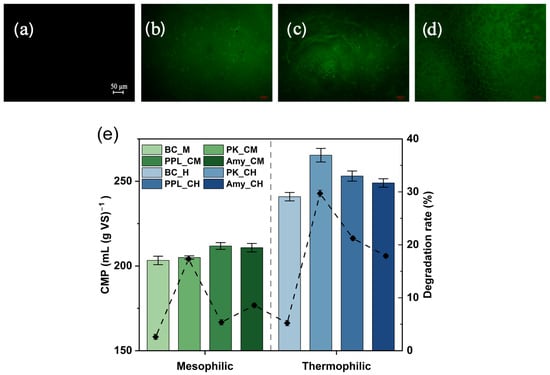
Figure 1
Open AccessArticle
A New Fuzzy Preference Relation (FPR) Approach to Prioritizing Drinking Water Hazards: Ranking, Mapping, and Operational Guidance
by
Izabela Piegdoń, Barbara Tchórzewska-Cieślak and Jakub Raček
Water 2025, 17(23), 3410; https://doi.org/10.3390/w17233410 (registering DOI) - 29 Nov 2025
Abstract
This paper presents a practical and auditable methodology for prioritizing drinking water hazards based on fuzzy preference relations (FPR). The method is based on additive pairwise comparisons of tap water quality parameters, which are aggregated (median) into a complete preference matrix. For each
[...] Read more.
This paper presents a practical and auditable methodology for prioritizing drinking water hazards based on fuzzy preference relations (FPR). The method is based on additive pairwise comparisons of tap water quality parameters, which are aggregated (median) into a complete preference matrix. For each parameter, a Fuzzy Priority Index (FPI) was determined as the average “advantage” over the others. The FPI values were mapped to five fuzzy priority levels (very low–very high) using triangular/trapezoidal membership functions, followed by a defuzzification process using the centroid of singletons (COGS) method. The final step is to map the categories to operational actions, ensuring a clear transition from assessment to decision (from routine monitoring to immediate intervention). The method was demonstrated on nine parameters that are relevant for regulatory (WHO/DWD) and operational purposes: As, Pb, THM, NO3−, Hg, Cr, Mn, Cu, Fe. Thirty-six pairwise assessments were determined, which, after aggregation, formed fuzzy relations. The resulting ranking (FPI) is: As (0.76) > Pb (0.70) > THM (0.64) > NO3− (0.56) > Hg (0.50) > Cr (0.43) > Mn (0.36) > Cu (0.30) > Fe (0.25). Fuzzy categorization assigned As, Pb, THM to the High level, NO3−, Hg, Cr to Medium, and Mn, Cu, Fe to Low, with the Score reflecting the “proximity” of higher levels. The approach is transparent, replicable, and supports sensitivity analysis. The combination of FPI with fuzzy categorization and a decision map transforms expert knowledge and uncertainty into prioritized, actionable steps for water safety management.
Full article
(This article belongs to the Section Water Quality and Contamination)
►▼
Show Figures
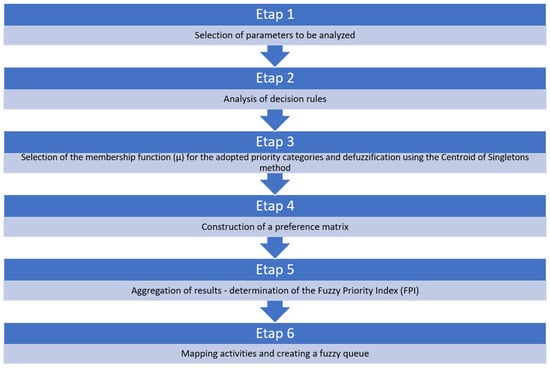
Figure 1
Open AccessReview
Advancements in Microbial Nitrogen Pathways for Sustainable Wastewater Treatment
by
Muhammad Shaaban, Kaiyan Zhou, Behnam Asgari Lajayer, Lei Wu, Aneela Younas and Yupeng Wu
Water 2025, 17(23), 3409; https://doi.org/10.3390/w17233409 (registering DOI) - 29 Nov 2025
Abstract
Over the past few decades, the discovery of novel microbial processes, biochemical reactions, and previously uncharacterized microorganisms has significantly enhanced our understanding of nitrogen (N) cycling across terrestrial and aquatic ecosystems, including engineered environments such as wastewater treatment systems. These scientific advancements are
[...] Read more.
Over the past few decades, the discovery of novel microbial processes, biochemical reactions, and previously uncharacterized microorganisms has significantly enhanced our understanding of nitrogen (N) cycling across terrestrial and aquatic ecosystems, including engineered environments such as wastewater treatment systems. These scientific advancements are catalyzing a paradigm shift toward treatment strategies that are not only energy-efficient and cost-effective, but also environmentally sustainable, with the added benefit of mitigating greenhouse gas emissions. The current review highlights recent breakthroughs in microbial N cycling, with particular emphasis on their practical applications in wastewater treatment. Emerging processes, such as nitrous oxide (N2O) mitigation, electro-anammox, ferric iron-dependent ammonium oxidation (Feammox), and complete ammonia oxidation (comammox), offer promising strategies for sustainable and low-energy N removal. Nevertheless, a significant challenge persists in translating these laboratory-scale innovations into full-scale, real-world applications, especially within decentralized treatment infrastructures. Bridging this gap is essential for realizing robust, low-carbon, and sustainable wastewater management systems in the decades to come.
Full article
(This article belongs to the Special Issue Advances in Biological Technologies for Wastewater Treatment)
►▼
Show Figures
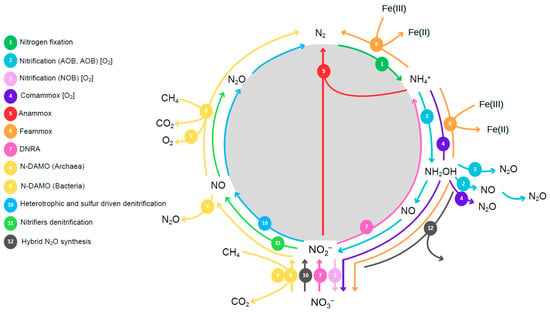
Figure 1
Open AccessArticle
Microbial Response of Fe and Mn Biogeochemical Processes in Hyporheic Zone Affected by Groundwater Exploitation Along Riverbank
by
Yijin Wang and Jun Pan
Water 2025, 17(23), 3408; https://doi.org/10.3390/w17233408 (registering DOI) - 29 Nov 2025
Abstract
In order to explore the co-evolutionary relationship between the functions of microbial communities and the chemical composition of groundwater in a hyporheic zone affected by groundwater exploitation along riverbank, we have taken the Huangjia water source area on the Liao River main stream
[...] Read more.
In order to explore the co-evolutionary relationship between the functions of microbial communities and the chemical composition of groundwater in a hyporheic zone affected by groundwater exploitation along riverbank, we have taken the Huangjia water source area on the Liao River main stream in Shenyang as an example. DNA was extracted from microorganisms in the hyporheic zone affected by groundwater exploitation along the riverbank, and we conducted high-throughput sequencing to select the dominant bacterial strains from the indigenous bacteria. They are classified as the Proteobacteria phylum, the Actinobacteria phylum, the Firmicutes phylum, the Bacteroidetes phylum, the Chloroflexi phylum, and the Acidobacteria phylum. The dominant bacteria have a good correlation with Fe, Mn, and environmental factors (such as DO—dissolved oxygen, Eh—oxidation-reduction potential, etc.) in the hyporheic zone. The functions and activities of the superior bacterial strains exhibit a feature of co-evolution with the water’s chemical environment, which has certain response characteristics to redox zoning. Studying the co-evolution relationship between the microbial community structure and function in the hyporheic zone and the chemical composition of the groundwater can provide a microbiological theoretical basis for the redox zonation. It also offers reference for understanding the process of Fe and Mn migration and transformation in the hyporheic zone under the hydrodynamic conditions of groundwater exploitation along the riverbank.
Full article
(This article belongs to the Section Ecohydrology)
►▼
Show Figures
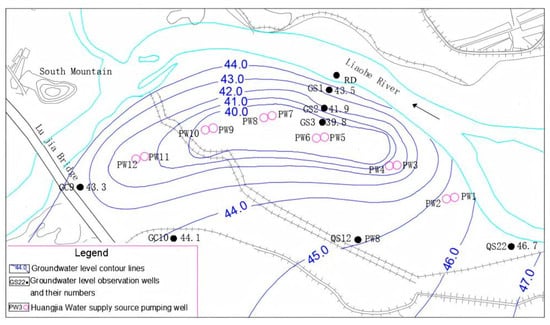
Figure 1
Open AccessArticle
A Multi-Scale Suitability Assessment Framework for Deep Geological Storage of High-Salinity Mine Water in Coal Mines
by
Zhe Jiang, Song Du, Songyu Ren, Qiaohui Che, Xiao Zhang and Yinglin Fan
Water 2025, 17(23), 3407; https://doi.org/10.3390/w17233407 (registering DOI) - 29 Nov 2025
Abstract
Deep well injection and storage (DWIS) technology provides an effective alternative to address the high cost, energy intensity, and limited scalability of conventional treatments for high-salinity mine water from coal mines. However, the absence of a dedicated site suitability evaluation framework remains a
[...] Read more.
Deep well injection and storage (DWIS) technology provides an effective alternative to address the high cost, energy intensity, and limited scalability of conventional treatments for high-salinity mine water from coal mines. However, the absence of a dedicated site suitability evaluation framework remains a major gap. Unlike previous approaches that directly applied CO2 storage criteria, this study refines and restructures the framework based on a systematic analysis of the fundamental differences in mechanisms and risk characteristics unique to mine water storage. Building on the experience of CO2 geological storage assessment, this study analyzes the key differences in fluid properties and storage mechanisms between water and CO2 and, for the first time, establishes a comprehensive site suitability evaluation framework for mine water geological storage. The framework integrates three main dimensions—stability and safety, effectiveness, and socio-economic factors—covering 80 key parameters. The indicator system is organized hierarchically at the basin, target-area, and site levels, and incorporates a multi-scale weight adaptation mechanism that assigns scale-dependent weights to the most influential indicators at each evaluation level. An innovative evaluation methodology combining a “one-vote veto” mechanism, progressive filtering, and multi-factor weighted superposition is proposed to determine storage suitability. This work fills a critical research gap in systematic site selection for deep mine water storage in China. It offers theoretical guidance and an engineering paradigm for overcoming technological bottlenecks in high-salinity water treatment, enabling efficient and low-carbon disposal. The study has important implications for promoting the green transformation of the mining industry and achieving national carbon peaking and neutrality goals.
Full article
(This article belongs to the Special Issue Mine Water Treatment, Utilization and Storage Technology)
►▼
Show Figures
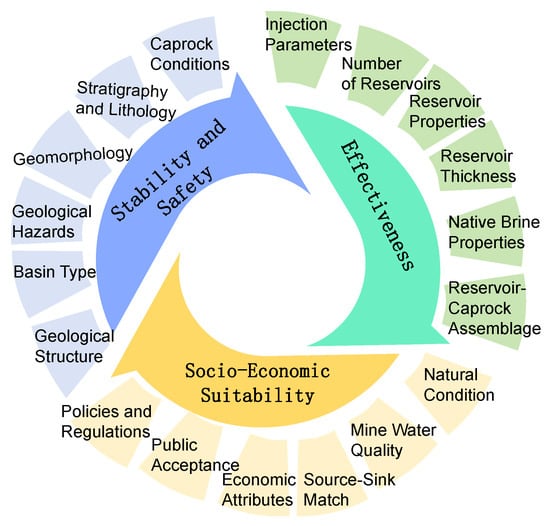
Figure 1
Open AccessArticle
Study on Transient Characteristics of New-Type Series-Parallel Emergency Drainage Pump During Unexpected Shutdown Process
by
Ding Tian, Kun Zhang, Yuanzhe Ju, Yong Zhang, Peng Wang and Qiaorui Si
Water 2025, 17(23), 3406; https://doi.org/10.3390/w17233406 (registering DOI) - 28 Nov 2025
Abstract
As key emergency equipment, high-flow pump devices play a vital role in urban flood control and drainage, and their hydraulic performance directly influences the safety and stability of the entire system. To meet diverse drainage demands during emergency operations, a new type of
[...] Read more.
As key emergency equipment, high-flow pump devices play a vital role in urban flood control and drainage, and their hydraulic performance directly influences the safety and stability of the entire system. To meet diverse drainage demands during emergency operations, a new type of high-flow drainage pump, capable of operating in series, parallel, and variable-speed modes, has been developed. Using the SST k-ω turbulence model combined with entropy production theory and pressure pulsation analysis, unsteady numerical simulations were conducted to investigate the transient internal flow under series and parallel operating conditions. The numerical model was verified through comparison with experimental hydraulic-performance data, demonstrating good agreement. The results show that under series operation, the pump speed decreases from 1500 r/min to 193 r/min before reversing to −1748 r/min, while under parallel operation the runaway speed reaches −1657 r/min. The flow rate and torque exhibit strong nonlinear variations, with reverse flow and oscillatory behavior appearing in the impeller passages. During the runaway stage, entropy production peaks at 28.17 W/K under series conditions and 29.09 W/K under parallel conditions, with turbulent dissipation accounting for more than 69% of the total. High-entropy regions extend toward the impeller outlet, while energy losses are predominantly concentrated in the secondary suction chamber, contributing 47.56% and 57.12% under the respective conditions. Pressure pulsation analysis indicates that the dominant frequency components are concentrated at the blade-passing frequency (100 Hz) and its harmonics, with the strongest fluctuations near the primary impeller outlet. These results provide theoretical and engineering guidance for improving the efficiency and stability of emergency drainage systems.
Full article
(This article belongs to the Section Hydraulics and Hydrodynamics)
Open AccessArticle
Booster Chlorination in Palestinian Schools: Field Investigation of Chlorination Dynamics in Central Hebron Directorate
by
Safa Sultan, Mohannad Nassar, Hassan Sawalha, Maher Jabari, Yaser Issa, Mohammad Abu Thrie, Gabriel Chevalier and Maryna Peter
Water 2025, 17(23), 3405; https://doi.org/10.3390/w17233405 (registering DOI) - 28 Nov 2025
Abstract
Intermittent water supply is common in Palestine, prompting schools to rely on on-site water storage systems, including underground and roof tanks. Prolonged and uncontrolled water storage leads to quality degradation, especially with free residual chlorine (FRC) depletion. Hence, this poses health risks to
[...] Read more.
Intermittent water supply is common in Palestine, prompting schools to rely on on-site water storage systems, including underground and roof tanks. Prolonged and uncontrolled water storage leads to quality degradation, especially with free residual chlorine (FRC) depletion. Hence, this poses health risks to students and staff. This pilot (field) study evaluated the effectiveness of booster chlorination under the current storage conditions to optimize and improve the existing chlorination process. Four schools were selected based on the type of water storage systems (two with underground tanks, two with roof tanks) and building age. Booster chlorination was applied at two chlorine doses (0.5 mg/L and 1 mg/L). FRC was monitored until levels dropped below 0.05 mg/L. Results show that the currently applied chlorine dose (0.5 mg/L) is insufficient to reach the minimum national FRC standard (0.2 mg/L) after 30 min. In contrast, a 1 mg/L chlorine dose is more effective in maintaining the minimum FRC concentration limit for a longer time. In addition, manual mixing is ineffective in large underground tanks, while it is effective in roof tanks. This study urges the need to revise the national chlorination guidelines and to adjust chlorination practices to ensure safe drinking water in schools.
Full article
(This article belongs to the Section Water Quality and Contamination)
Open AccessArticle
Mangrove Zonation as a Tool to Infer the Freshwater Inflow Regime in the Data-Poor Ruvu Estuary, Tanzania
by
Amartya Kumar Saha and Michael Honorati Kimaro
Water 2025, 17(23), 3404; https://doi.org/10.3390/w17233404 (registering DOI) - 28 Nov 2025
Abstract
Estuaries provide numerous ecosystem services, including fisheries, coastal community livelihoods, and resistance to saltwater intrusion. Despite this knowledge, estuaries worldwide are threatened by decreasing and/or aseasonal freshwater inflows, which negatively affect ecosystem structure and function. Sound estuarine management requires an understanding of the
[...] Read more.
Estuaries provide numerous ecosystem services, including fisheries, coastal community livelihoods, and resistance to saltwater intrusion. Despite this knowledge, estuaries worldwide are threatened by decreasing and/or aseasonal freshwater inflows, which negatively affect ecosystem structure and function. Sound estuarine management requires an understanding of the natural freshwater inflow regime and knowledge of the salinity tolerances of local plant and animal communities—data that are completely lacking in most estuaries. This paper describes a 2-week field survey of mangrove zonation in the Ruvu River estuary carried out during the wet–dry season transition to obtain a multi-decadal proxy for the salinity regime within the estuary. Salinity conditions arising from the mixing of freshwater inflows and sea tides influence the species composition of mangroves. The mouth of the estuary (highest salinity −35 ppt) had monospecific stands of Sonneratia alba—the mangrove with the highest salinity tolerance. Salinity decreased going upriver, from 30 ppt to 5 ppt over 13 km, with 7 other mangrove species progressively appearing in the riverbank forests, ultimately transitioning to palms and other trees intolerant of salinity (<5 ppt). The resulting map relating mangrove zonation with salinity can then be used to calibrate estuary salinity mixing models for calculating minimum freshwater inflows necessary to maintain the estuarine ecosystem. Such periodic surveys and maps can also serve to calibrate/validate remote sensing products for continued coastal vegetation monitoring. The study also reviews available information on climate and land use relating to river flow in the Ruvu basin to summarize the hydrologic vulnerability of the Ruvu estuary to climate change, land use change, and river water demands in the Basin.
Full article
(This article belongs to the Special Issue Impacts of Environmental Change and Human Activities on Aquatic Ecosystems, 2nd Edition)
Open AccessEditorial
Urban Water Pollution Control: Theory and Technology
by
Bingdang Wu, Yonghai Gan and Jingjing Yang
Water 2025, 17(23), 3403; https://doi.org/10.3390/w17233403 (registering DOI) - 28 Nov 2025
Abstract
Water security and robust sanitation infrastructure are fundamental pillars supporting public health, ecological integrity, and sustainable urban development [...]
Full article
(This article belongs to the Special Issue Urban Water Pollution Control: Theory and Technology)
Open AccessArticle
An Integrated Risk Assessment for Snow Disasters in Jilin Province, China: Insights from Multi-Source Data and GIS Analysis
by
Yao Wang, Chongchang Wang, Qian Yang, Shangfeng Li, Yingxin Shang and Xuetong Zhang
Water 2025, 17(23), 3402; https://doi.org/10.3390/w17233402 (registering DOI) - 28 Nov 2025
Abstract
Snow disasters are severe natural hazards in Jilin Province, China. This research formulated a holistic risk assessment framework which integrates the factors of hazardousness, sensitivity, vulnerability, and disaster prevention and mitigation capacity. Using multi-source data and Geographic Information System (GIS), we evaluated snow
[...] Read more.
Snow disasters are severe natural hazards in Jilin Province, China. This research formulated a holistic risk assessment framework which integrates the factors of hazardousness, sensitivity, vulnerability, and disaster prevention and mitigation capacity. Using multi-source data and Geographic Information System (GIS), we evaluated snow disaster risks through 15 selected indicators weighted by the entropy method. Results show high-risk areas primarily concentrated in southeastern mountainous regions, including Jingyu, Fusong, Changbai, and Linjiang. Disaster sensitivity decreases from southeast to northwest, while high-vulnerability zones appear in central urban areas like Changchun. The comprehensive risk generally declines from the southeastern mountains to the northwestern plains. This assessment model effectively reflects snow disaster formation mechanisms and spatial patterns, providing scientific support for disaster prevention and emergency management in Jilin Province.
Full article
(This article belongs to the Special Issue Advances and Challenges in the Lake, River, and Sea Ice Sciences and Engineering)
Open AccessArticle
Analytical Model for Three-Dimensional Reactive Transport of Coexisting Chlorinated Solvent Contaminants in Groundwater under Time-Varying Source Discharge Concentrations Induced by Remediation Efforts
by
Zhong-Yi Liao, Heejun Suk, Thu-Uyen Nguyen, Chen-Wuing Liu, Ching-Ping Liang and Jui-Sheng Chen
Water 2025, 17(23), 3401; https://doi.org/10.3390/w17233401 (registering DOI) - 28 Nov 2025
Abstract
Chlorinated solvents, common groundwater contaminants, can cause coexistence of the original contaminant and its degradation products during the transport process. Practically applicable analytical models for reactive transport are essential for simulating the plume migration of chlorinated solvent contaminants and their degradation products within
[...] Read more.
Chlorinated solvents, common groundwater contaminants, can cause coexistence of the original contaminant and its degradation products during the transport process. Practically applicable analytical models for reactive transport are essential for simulating the plume migration of chlorinated solvent contaminants and their degradation products within a complex chemical mixture. Although several analytical models have been developed to solve advection–dispersion equations coupled with a series of decay reactions for simulating transport of the coexisting chlorinated solvent contaminants, the majority assume static, time-invariant inlet boundary conditions. Such time-invariant inlet boundary conditions may fail to adequately represent the temporal evolution of dissolved source discharge concentration concerning mass reduction, especially in the context of diverse DNAPL source remediation strategies. This study seeks to derive analytical models for three-dimensional reactive transport of multiple contaminants, specifically addressing the challenges posed by dynamical, time-varying inlet boundary conditions. The model development incorporates two distinct inlet functions: exponentially decaying and piecewise constant. Analytical solutions are obtained using three integral transform techniques. The accuracy of the newly developed analytical models is verified by comparing them with solutions derived from existing literature using multiple illustrative examples. By incorporating two distinct time-varying inlet boundary conditions, the models exhibit strong capabilities in capturing the complex transport dynamics and fate of contaminants within groundwater systems. These features make the models valuable tools for improving the understanding of subsurface contaminant behavior and for quantitatively evaluating and optimizing a range of remediation strategies.
Full article
(This article belongs to the Section Hydrology)
Open AccessArticle
Road Collapse Induced by Pipeline Leakage in Water-Rich Sand: Experiments and Computational Fluid Dynamics-Discrete Element Method Simulations
by
Niannian Wang, Peijia Yang, Xingyi Wang, Jiaqing Zheng and Hongyuan Fang
Water 2025, 17(23), 3400; https://doi.org/10.3390/w17233400 (registering DOI) - 28 Nov 2025
Abstract
To investigate the mechanism of road collapse induced by structural defects in underground drainage/sewerage pipelines in water-rich sands, laboratory physical model tests were conducted to reproduce the macroscopic development of surface subsidence. A computational fluid dynamics-discrete element method (CFD-DEM) model was then established
[...] Read more.
To investigate the mechanism of road collapse induced by structural defects in underground drainage/sewerage pipelines in water-rich sands, laboratory physical model tests were conducted to reproduce the macroscopic development of surface subsidence. A computational fluid dynamics-discrete element method (CFD-DEM) model was then established and validated against the tests to assess its reliability. Using the validated model, we examined the effects of defect size and groundwater level on the progression of groundwater-ingress-driven internal erosion and tracked the evolution of vertical stress and intergranular contacts around the pipe. Results show that internal erosion proceeds through three stages—initial erosion, slow settlement, and collapse—culminating in an inverted-cone collapse pit. After leakage onset, the vertical stress in the surrounding soil exhibits a short-lived surge followed by a decline on both sides above the pipe. The number of intergranular contacts decreases markedly; erosion propagates preferentially in the horizontal direction, where the reduction in contacts is most pronounced. Within the explored range, higher groundwater levels and larger defects accelerate surface settlement and yield deeper and wider collapse pits. Meanwhile, soil anisotropy strengthens with increasing groundwater level but peaks and then slightly relaxes as defect size grows. These qualitative findings improve understanding of the leakage-induced failure mechanism of buried pipelines and offer references for discussions on monitoring, early warning, and risk awareness of road collapses.
Full article
(This article belongs to the Section Hydrogeology)
►▼
Show Figures

Figure 1
Open AccessArticle
Phosphorus Regulated Coordination of Carbon, Nitrogen, Sulfur and Phosphorus Cycling Genes in Sediments of a Plateau Mesotrophic Lake Erhai in Yunnan, China
by
Zhen Xie, Shunzi Xiong, Huaji Liu, Jimeng Feng, Xiaoyi Chen, Kaiwen Yang, Lei Zhang, Xinze Wang and Xiaojun Zhang
Water 2025, 17(23), 3399; https://doi.org/10.3390/w17233399 - 28 Nov 2025
Abstract
Eutrophication threatens vulnerable plateau lakes, yet the gene-level microbial processes behind spatial heterogeneity of sediment carbon (C), nitrogen (N), phosphorus (P) and sulfur (S) cycling and their environmental driver remain unclear. This study first applies the high-throughput Quantitative Microbial Ecology Chip (QMEC) to
[...] Read more.
Eutrophication threatens vulnerable plateau lakes, yet the gene-level microbial processes behind spatial heterogeneity of sediment carbon (C), nitrogen (N), phosphorus (P) and sulfur (S) cycling and their environmental driver remain unclear. This study first applies the high-throughput Quantitative Microbial Ecology Chip (QMEC) to quantify 71 functional genes involved in geochemical cycling in sediment of a large Chinese plateau lake, Erhai, aiming to elucidate how environmental factors shape the spatial distribution and coupling patterns of these genes. The results revealed that total functional gene abundance exhibited a pronounced south-to-north decline, with key genes (rbcL, mct, nirS, nosZ, phoD, pqqC and yedZ) being significantly higher in the southern sector (p < 0.05). Lignocellulose-degrading genes (abfA, xylA and mnp) exceeded 106 copies g−1 and were significantly enriched in the south, indicating faster organic-matter turnover. Denitrification dominated the nitrogen cycle, with nirS-type denitrifiers being overwhelmingly prevalent; genes associated with nitrate reduction (napA, narG) were also significantly more abundant in the south. Sediment total phosphorus (TP) was significantly correlated with genes involved in carbon fixation, methane production, nitrogen fixation and sulfur metabolism (Mantel test, p < 0.05), suggesting that TP is a key driver of microbial nutrient cycling in Erhai sediment. Furthermore, co-abundance of these functional genes was observed across all sites (Spearman correlation, p < 0.05), which in turn implies potential coupling of the major elemental cycles. Accordingly, the differentiation of the carbon, nitrogen, phosphorus and sulfur cycling genes and metabolic potential in the different sectors reveals heterogeneous microbial regulation of Erhai’s endogenous nutrient cycling. It highlights precision and differentiated management as a key for large lake restoration.
Full article
(This article belongs to the Section Biodiversity and Functionality of Aquatic Ecosystems)
►▼
Show Figures

Graphical abstract
Open AccessArticle
Assessment of Groundwater Environmental Quality and Analysis of the Sources of Hydrochemical Components in the Nansi Lake, China
by
Beibei Yan, Xiaofang Lv, Tao Wang, Min Wang, Ruilin Zhang, Chengyuan Song, Xinyi Shen and Hengyi Zhao
Water 2025, 17(23), 3398; https://doi.org/10.3390/w17233398 - 28 Nov 2025
Abstract
Groundwater in the Nansi Lake Basin, a key reservoir of the South-to-North Water Diversion Project, supports domestic, agricultural, and ecological needs but faces pressure from overexploitation and pollution. This study clarifies the hydrochemical characteristics, controlling processes, environmental quality, and source contributions of shallow
[...] Read more.
Groundwater in the Nansi Lake Basin, a key reservoir of the South-to-North Water Diversion Project, supports domestic, agricultural, and ecological needs but faces pressure from overexploitation and pollution. This study clarifies the hydrochemical characteristics, controlling processes, environmental quality, and source contributions of shallow groundwater in the basin. Hydrochemical data from 67 wells were interpreted using Piper and Schukalev diagrams, Gibbs and ion-ratio plots, the entropy-weight water quality index (EWQI), and an absolute principal component scores–multiple linear regression (APCS-MLR) model. Groundwater shows high mineralization and hardness, with 35.82% and 55.22% of samples exceeding standard limits for total dissolved solids and total hardness, respectively. The dominant facies are HCO3-Ca, HCO3-Ca·Mg, and HCO3·Cl-Na·Ca, indicating dissolution and ion exchange involving carbonate and silicate rocks. Gibbs and ion-ratio analyses demonstrate that rock–water interaction is the main control, with secondary influence from evaporation. EWQI results indicate generally good groundwater quality (68.66% Class I, 20.90% Class II). APCS-MLR identifies natural, agricultural, ion-exchange, and anthropogenic sources, contributing 53.34%, 22.71%, 4.79% and 19.14%, respectively. These findings show that protection should focus on pollution control in northern agricultural and mining zones while conserving high-quality groundwater elsewhere in the basin.
Full article
(This article belongs to the Section Hydrogeology)
►▼
Show Figures

Figure 1
Open AccessArticle
Spatiotemporal Changes in Grassland Yield and Driving Factors in the Kherlen River Basin (2000–2024): Insights from CASA Modeling and Geodetector Analysis
by
Meihuan Yang, Haowei Yang, Tao Wang, Pengfei Li, Juanle Wang, Yating Shao, Ting Li, Jingru Zhang and Bo Wang
Water 2025, 17(23), 3397; https://doi.org/10.3390/w17233397 - 28 Nov 2025
Abstract
The Kherlen River Basin is a typical basin in the eastern Mongolian Plateau and is dominated by grassland. This study estimated the grassland yield in the Kherlen River Basin using the Carnegie–Ames–Stanford approach (CASA) model, combined with Theil–Sen median trend analysis and the
[...] Read more.
The Kherlen River Basin is a typical basin in the eastern Mongolian Plateau and is dominated by grassland. This study estimated the grassland yield in the Kherlen River Basin using the Carnegie–Ames–Stanford approach (CASA) model, combined with Theil–Sen median trend analysis and the Geodetector, to explore its spatiotemporal changes and driving factors. This integrated framework links temporal trend detection with spatial interaction analysis to better reveal ecological responses to climatic and anthropogenic influences. The results showed the following: (1) The root mean square error (RMSE) between the estimated grassland yield and the laboratory measurements was 37.88 g/m2, with an estimation accuracy (EA) of 73.52%. (2) From 2000 to 2024, the grassland yield increased significantly at a rate of 1.98 g/(m2·a) (p < 0.05), with the fastest growth in the middle reaches. (3) Spatially, 79.78% of the basin exhibited significant increases, mainly in the central and western regions. The proportion of significant increase was highest in the upper reaches (40.36%), followed by the middle (32.89%) and lower reaches (6.53%). (4) Due to limited temporal resolution of socioeconomic data, the driving factor analysis covered the period 2000–2020, during which the overall grassland yield was primarily influenced by the interaction between precipitation and elevation (q = 0.6371). Specifically, the upper, middle, and lower reaches were mainly influenced by the interactions between temperature and precipitation (q = 0.6772), precipitation and elevation (q = 0.6377), and temperature and elevation (q = 0.4255), respectively. The study indicates that grassland yield in the Kherlen River Basin exhibited an overall increasing trend during 2000–2024, with climatic factors (precipitation and temperature) and the geographic factor (elevation) identified as the dominant drivers. The influence of human activities was not significant, although this result may be affected by uncertainties associated with data resolution limitations. Future work should incorporate higher-resolution remote sensing and socioeconomic datasets to better assess the impacts of human activities.
Full article
(This article belongs to the Special Issue Applications of Remote Sensing and GISs in River Basin Ecosystems, 2nd Edition)
►▼
Show Figures

Figure 1
Open AccessArticle
Reconstruction of Daily Runoff Series in Data-Scarce Areas Based on Physically Enhanced Seq-to-Seq-Attention-LSTM Model
by
Zhaokai Yin, Tao Xu, Huiqiang Ye, Lin Wang and Lili Liang
Water 2025, 17(23), 3396; https://doi.org/10.3390/w17233396 - 28 Nov 2025
Abstract
With the advancement of remote sensing-based river discharge monitoring in data-scarce regions, reconstructing daily streamflow series from remote sensing data has become a critical hydrological challenge. To address the sparsity of remote sensing inversions and the discontinuity of discharge observations, we propose a
[...] Read more.
With the advancement of remote sensing-based river discharge monitoring in data-scarce regions, reconstructing daily streamflow series from remote sensing data has become a critical hydrological challenge. To address the sparsity of remote sensing inversions and the discontinuity of discharge observations, we propose a physics-enhanced deep learning model—Physics-enhanced Seq-to-Seq Attention LSTM (PSAL)—to achieve high-accuracy daily streamflow reconstruction. The model incorporates input structures aligned with hydrological mechanisms, providing a physically meaningful basis for interpretability and enabling physics-guided learning. Results show that (1) PSAL achieves high reconstruction accuracy across five representative gauging sites on the Jinsha River (mean NSE = 0.81). Among lagged output configurations from T-1 to T-7 days, the T-7 setting yields the best performance (mean NSE = 0.85). (2) Compared with a baseline Seq-to-Seq Attention LSTM model without physics-enhanced features, PSAL significantly improves reconstruction skill (mean ΔNSE = 0.76). Feature ablation analysis further reveals that precipitation, as a key driver of runoff, has a strong influence on model performance (mean ΔNSE = 0.32). This study presents a novel approach that integrates physical knowledge with data-driven methods for streamflow reconstruction in remote sensing-dominated, data-scarce regions, offering theoretical support and methodological guidance for digital twin watershed development and historical hydrological data infilling.
Full article
(This article belongs to the Special Issue Catchment Ecohydrology)
►▼
Show Figures

Figure 1
Open AccessArticle
Settlement Induction in Mytilus coruscus Is Driven by Cue Diversity: Evidence from Natural Biofilms and Bacterial Isolates
by
Ni Chen, Yonghui Fu, Qianyu Zhang, Jie Du, Wanting Liu, Xinjie Liang, Yingying Ye and Jiji Li
Water 2025, 17(23), 3395; https://doi.org/10.3390/w17233395 - 28 Nov 2025
Abstract
Mytilus coruscus, a commercially important mariculture mussel in China, has shown a marked decline in larval settlement and metamorphosis over the past decade, a trend often linked to environmental degradation and resource depletion. Numerous studies have identified bacterial biofilms as key modulators
[...] Read more.
Mytilus coruscus, a commercially important mariculture mussel in China, has shown a marked decline in larval settlement and metamorphosis over the past decade, a trend often linked to environmental degradation and resource depletion. Numerous studies have identified bacterial biofilms as key modulators of mussel larval settlement. To investigate this, we deployed PVC plates in situ within aquaculture zones near Shengsi (Zhoushan, Zhejiang) and Lianjiang (Fuzhou, Fujian). After natural biofilm colonization on the plates, juvenile M. coruscus were introduced to assess settlement rates. The attached juveniles were homogenized, leading to the isolation of four dominant bacterial strains: Pseudomonas sp. LJBF001, Vibrio sp. LJBF002, Pseudomonas sp. LJBF003 and Bacillus sp. LJBF004. Compared to control PVC plates, natural biofilms significantly promoted juvenile settlement, with the Lianjiang (LJ) group reaching up to >29% under our assay conditions. In contrast, monospecific biofilms prepared from these isolates did not significantly increase larval metamorphosis; the numerically highest response (LJBF004) reached ~9% and was not significant versus the control. These contrasting outcomes are consistent with a threshold–multi-cue synergy mechanism, whereby cue diversity and partial redundancy in natural biofilms favour threshold crossing, while restricted cue sets in single-strain films often fall short. Guided by this framework, priority next steps include testing c-di-GMP delivery (soluble and via OMVs), probing EPS structure–function and EPS–OMV/LPS–free-fatty-acid blends alongside minimal multi-strain consortia, and adopting stage-gated assays with time-to-event endpoints and effect-size/CI reporting.
Full article
(This article belongs to the Section Water, Agriculture and Aquaculture)
►▼
Show Figures

Figure 1
Open AccessReview
Microplastic Removal by Flotation: Systematic Review, Meta-Analysis, and Research Trends
by
Theerayut Phengsaart, Palot Srichonphaisarn, Mylah Villacorte-Tabelin, Marthias Silwamba, Dao Janjaroen, Carlito Baltazar Tabelin, Dennis Alonzo, Anh Tuan Ta and Onchanok Juntarasakul
Water 2025, 17(23), 3394; https://doi.org/10.3390/w17233394 - 28 Nov 2025
Abstract
Microplastic (MP) pollution is a global concern due to its persistence, ubiquity, and potential ecological and health risks. Although various MP separation techniques exist, flotation has gained attention as a promising approach adapted from mineral processing. This study provides a systematic review, bibliometric
[...] Read more.
Microplastic (MP) pollution is a global concern due to its persistence, ubiquity, and potential ecological and health risks. Although various MP separation techniques exist, flotation has gained attention as a promising approach adapted from mineral processing. This study provides a systematic review, bibliometric analysis, and meta-analysis of MP removal using flotation, covering 31 papers published between 2015 and 2024. Research output has grown rapidly since 2020, with China (including Hong Kong) as the leading contributor with strong international collaborations. Bibliometric mapping highlighted hotspots such as polymer type, particle size, contact angle, and nanobubbles. Meta-analysis showed that flotation achieved high removal efficiencies across water and solid matrices, though performance varies with polymer properties, surfactants used, and experimental design. Studies focused on solid particles remain limited, reflecting greater methodological challenges than in water systems. Critical discussion emphasized the need for standardized protocols, scaling from laboratory to field applications, and integration with wastewater treatment. This review identified knowledge gaps and emerging trends that can inform the future development of flotation as an effective technology for mitigating MP pollution.
Full article
(This article belongs to the Special Issue Aquatic Microplastic Pollution: Occurrence and Removal)
►▼
Show Figures

Figure 1

Journal Menu
► ▼ Journal Menu-
- Water Home
- Aims & Scope
- Editorial Board
- Reviewer Board
- Topical Advisory Panel
- Instructions for Authors
- Special Issues
- Topics
- Sections & Collections
- Article Processing Charge
- Indexing & Archiving
- Editor’s Choice Articles
- Most Cited & Viewed
- Journal Statistics
- Journal History
- Journal Awards
- Society Collaborations
- Editorial Office
Journal Browser
► ▼ Journal BrowserHighly Accessed Articles
Latest Books
E-Mail Alert
News
Topics
Topic in
Applied Nano, Catalysts, Molecules, Nanomaterials, Water, Gels, Polymers
Water Purification and Catalytic Disintegration at the Nanoscale
Topic Editors: Michael Arkas, Ioannis Pashalidis, Dimitrios A. Giannakoudakis, Ioannis P. AnastopoulosDeadline: 30 November 2025
Topic in
Energies, Membranes, Minerals, Water
Water-Energy Nexus in Mining Industry
Topic Editors: Sergio Santoro, Francesco Chidichimo, Barbara Ruffino, Lourdes García-Rodríguez, Sunil Kumar TripathyDeadline: 31 December 2025
Topic in
Agriculture, Climate, Sustainability, Water, Resources
Advances in Water and Soil Management Towards Climate Change Adaptation
Topic Editors: Nektarios N. Kourgialas, Ioannis Anastopoulos, Alexandros I. StefanakisDeadline: 30 January 2026
Topic in
Atmosphere, Coasts, Land, Sustainability, Water
Contemporary Waterfronts, What, Why and How?
Topic Editors: Maria José Andrade Marques, Francesca Dal Cin, João Pedro CostaDeadline: 28 February 2026

Special Issues
Special Issue in
Water
Hydrodynamics in Pressurized Pipe Systems
Guest Editor: Kamil UrbanowiczDeadline: 30 November 2025
Special Issue in
Water
Ecosystem, Groundwater, and Soil Contamination: Detection, Impact Assessment, and Remediation Strategies
Guest Editor: Kabari SamDeadline: 30 November 2025
Special Issue in
Water
New Methods and Technologies of Urban Flood Forecasting, Risk Assessment and Response
Guest Editors: Ganggang Zuo, Jiancang XieDeadline: 30 November 2025
Special Issue in
Water
Application of Bioremediation in Groundwater and Soil Pollution
Guest Editors: Aizhong Ding, Dayi ZhangDeadline: 30 November 2025





